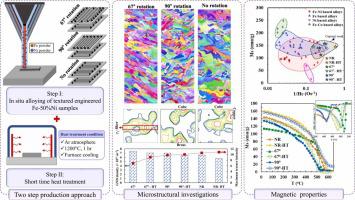Journal of Materials Processing Technology ( IF 6.7 ) Pub Date : 2022-07-26 , DOI: 10.1016/j.jmatprotec.2022.117733 Farahnaz Haftlang , Eun Seong Kim , Hyoung Seop Kim

|
The present study focused on improving the magnetic properties of in-situ synthesized Fe–Ni permalloy by engineering the predominant crystallographic texture. To this end, Fe–50 %Ni samples with homogeneous distributions of Fe and Ni were produced using three different rotation strategies through the directed energy deposition method and subsequent heat treatment. According to subsequent microstructural and crystallographic investigations, a pronounced S {123} 〈634〉 texture component and γ-fiber texture were detected in the as-printed sample produced by 67° rotation, resulting in a relatively undesirable magnetic response. Better magnetic properties were achieved in the 90° rotation strategy, with the Cube {001} 〈100〉 and Brass {011} 〈211〉 texture components predominating, and in the no rotation strategy, with the Cube {001} 〈100〉 and Copper {112} 〈111〉 texture components predominating. Heat treatment increased the intensity of the predominant texture components with no significant changes in grain size. On the other hand, short-time heat treatment for the purposes of texture sharpening and dislocation density reduction enhanced the magnetization saturation, coercivity, and Curie temperature values to ~160 emg/g, 1.7 Oe, and ~540 °C, respectively. These findings demonstrate that in comparison with the conventional process, the two-step production approach consisting of crystallographic texture-engineered laser-based in situ alloying additive manufacturing and short-time heat treatment is an efficient route for enhancing the magnetic performance of soft magnetic materials.
中文翻译:

使用增材制造原位合金化的 Fe-Ni 坡莫合金的晶体取向相关磁性能
本研究的重点是通过设计主要的晶体织构来改善原位合成的 Fe-Ni 坡莫合金的磁性。为此,通过定向能量沉积法和随后的热处理,使用三种不同的旋转策略生产了 Fe 和 Ni 分布均匀的 Fe-50%Ni 样品。根据随后的微观结构和晶体学研究,在通过 67° 旋转产生的印刷样品中检测到明显的 S {123} <634> 织构成分和 γ 纤维织构,导致相对不希望的磁响应。在 90° 旋转策略中获得了更好的磁性,其中立方体 {001} <100> 和黄铜 {011} <211> 纹理成分占主导地位,而在无旋转策略中,Cube {001} <100> 和 Copper {112} <111> 纹理成分占主导地位。热处理增加了主要织构成分的强度,而晶粒尺寸没有显着变化。另一方面,以纹理锐化和位错密度降低为目的的短时间热处理将磁化饱和度、矫顽力和居里温度值分别提高到~160 emg/g、1.7 Oe 和~540 °C。这些发现表明,与传统工艺相比,由晶体织构工程激光原位合金化增材制造和短时热处理组成的两步生产方法是提高软磁材料磁性能的有效途径。 . 热处理增加了主要织构成分的强度,而晶粒尺寸没有显着变化。另一方面,以纹理锐化和位错密度降低为目的的短时间热处理将磁化饱和度、矫顽力和居里温度值分别提高到~160 emg/g、1.7 Oe 和~540 °C。这些发现表明,与传统工艺相比,由晶体织构工程激光原位合金化增材制造和短时热处理组成的两步生产方法是提高软磁材料磁性能的有效途径。 . 热处理增加了主要织构成分的强度,而晶粒尺寸没有显着变化。另一方面,以纹理锐化和位错密度降低为目的的短时间热处理将磁化饱和度、矫顽力和居里温度值分别提高到~160 emg/g、1.7 Oe 和~540 °C。这些发现表明,与传统工艺相比,由晶体织构工程激光原位合金化增材制造和短时热处理组成的两步生产方法是提高软磁材料磁性能的有效途径。 . 用于纹理锐化和位错密度降低的短时间热处理将磁化饱和度、矫顽力和居里温度值分别提高到 ~160 emg/g、1.7 Oe 和 ~540 °C。这些发现表明,与传统工艺相比,由晶体织构工程激光原位合金化增材制造和短时热处理组成的两步生产方法是提高软磁材料磁性能的有效途径。 . 用于纹理锐化和位错密度降低的短时间热处理将磁化饱和度、矫顽力和居里温度值分别提高到 ~160 emg/g、1.7 Oe 和 ~540 °C。这些发现表明,与传统工艺相比,由晶体织构工程激光原位合金化增材制造和短时热处理组成的两步生产方法是提高软磁材料磁性能的有效途径。 .











































 京公网安备 11010802027423号
京公网安备 11010802027423号